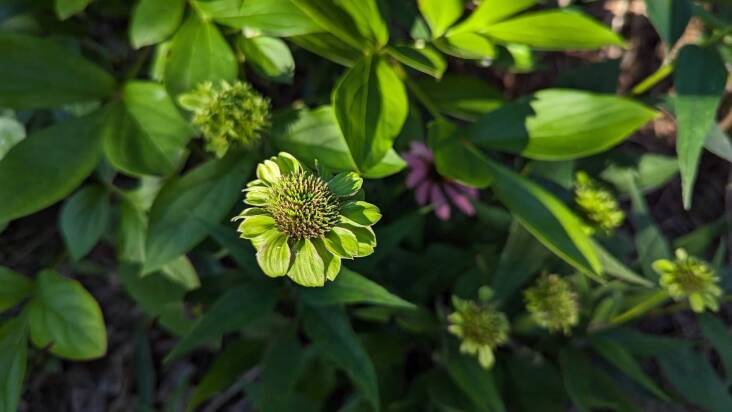As you walk around your garden, something catches your eye: a flower or plant you don’t remember planting. Or did you? Upon closer inspection, you realize you did plant it. But something is wrong. Very wrong.
Your echinacea flowers are not purple, and the petals are short and green. And some of the flower heads look alien, with little flowers growing out of them. It’s maybe kind of cool-looking? And definitely kind of disturbing. What’s happening to your favorite flowers?
Misshapen flower heads and petals and unusual growth are tell-tale signs of aster yellows, a disease that affects over 300 plants. Here’s what you need to know about it.
Photography by Joy Yagid.
What is ‘aster yellows’?

Aster yellows is a serious disease that affects mainly plants in (but not limited to) the Asteraceae family. These include asters, coneflowers, black-eyed Susans, coreopsis, zinnias, sunflowers, and marigolds, to name a few. It can also affect carrots, tomatoes, and lettuce. While not fatal to the plant, the disease causes bizarre abnormal growth. The disease gets its name from the yellow-ish hue of infected plants; it causes chlorosis, a yellowing of the body or the leaves while the veins remain green.
How can you tell if a plant has aster yellows?
Aster yellows can present as unusually colored and shaped petals, flower heads growing out of flower heads, stunted growth, and distorted leaves. One of the most common plants affected is the ubiquitous coneflower (Echinacea spp.). While the flower heads growing out of flower heads can be created by genetic modification on purpose (e.g., Echinacea purpurea x ‘Doubledecker’), the abnormalities brought on by aster yellows aren’t wanted nor are they pretty.

Don’t get aster yellows confused with the coneflower rosette mite, which causes abnormal growth only in the flower head and can be controlled by removal of just the flowerhead. Herbicides can cause abnormal growth as well; keep them away from your garden beds.
How does it spread?

It’s spread mainly by aster leafhoppers that are infected with phytoplasma, a bacteria-like pathogen. When the leafhopper feeds on an infected plant, it sucks in the phytoplasma. It spreads the pathogen when it hops to a new plant and noshes on that. The phytoplasma infects every part of the plant and causes abnormal growth.
What should I do if my plants have aster yellows?

There is no treatment or cure, unfortunately. Prevention and quick removal are key. The weather, which you can’t control, plays a part in the spread of the disease. Leafhoppers and the phytoplasma like cool and wet summers and not hot and dry ones. They travel on storm fronts up from the southern United States in the spring. You will need to be more vigilant when the weather is cooler and wetter than normal, or if you have a higher amount of spring storms.
Leafhoppers are hard to control. Pesticides are ineffective, because leafhoppers move fast and there is the high possibility of killing non-target insects, including pollinators. Physical barriers between plants can stop the leafhoppers but can be awkward or unsightly in the home garden.
The best thing to do if you spot an infection is to pull the entire plant, roots and all, and destroy it. Immediate removal can help stop the spread in your garden. This is not a soil or airborne disease, so there’s need to dig up anything but the roots. If you have a patch of coneflowers with only a few infected plants, pull only the infected ones, and watch the others. You may not need to pull all of them.
Other ways to prevent aster yellows and control its spread:
- Remove certain weeds like dandelions and broadleaf plantains since they can be a disease reservoir.
- Plant less susceptible plants and plant them in between susceptible plants.
- Choose plants, like salvia, cranesbill, verbena, nicotiana, cockscomb, and impatiens, that are not susceptible to asters yellows.
See also:
- Got Powdery Mildew in Your Garden? How to Identify and Eradicate It
- Search & Destroy: Scarlet Lily Beetles
- The Garden Decoder: What Is ‘Integrated Pest Management’?












Have a Question or Comment About This Post?
Join the conversation